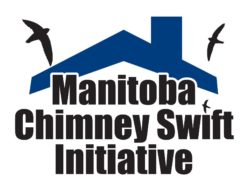 We are heading into the home stretch…the end of July is in sight and the calendar is getting ready to flip over to August – our last full month with Chimney Swifts in Manitoba. It is time for a nest site update and a review of the remarkable developments made by our volunteers. Monitors continued to track nest site progress and roost site dynamics. The number of newly discovered active sites for our critical habitat registry has swollen in July. Here’s what happened…
We are heading into the home stretch…the end of July is in sight and the calendar is getting ready to flip over to August – our last full month with Chimney Swifts in Manitoba. It is time for a nest site update and a review of the remarkable developments made by our volunteers. Monitors continued to track nest site progress and roost site dynamics. The number of newly discovered active sites for our critical habitat registry has swollen in July. Here’s what happened…
Our last blog update focused on nest sites and how to identify hatching and feeding brooded young; there is a subtle transition from one entry/exit cycle per hour seen during incubation to two entry/exit cycles per hour for the feeding brooded young stage. On Day 6-7, juveniles can regulate their own temperatures. Then, both parents can leave the chimney to forage. The key to identifying the feeding non-brooded young stage is consecutive entries or exits.
Saturday, July 9, Day 7 at the St Adolphe Church (hatching took place on July 3); 9:50-10:50 AM:
10:15:51 entry
10:22:24 entry = two consecutive entries; the nest site was unattended from at least 9:50 AM to 10:15 AM
10:23:05 exit – one swift is in the chimney
10:32:31 entry – two swifts are in the chimney
10:32:51 exit – likely a partner exchange
10:45:40 entry – two swifts are in the chimney
10:46:05 exit – one swift was in the chimney at the end of the monitoring session
The feeding rate was 4 X per hour.
Around Day 21, the juveniles move from the bowl of the nest to the wall of the chimney. A lot of wing flapping takes place to exercise flight muscles. Eventually, mini-training flights take place up and down the chimney shaft. The adults start to draw the juveniles up to the rim of the chimney with repetitive entries and exits…fledging is the next important milestone.
Fledging occurs on Day 28-30. For the Church birds, the date range for fledging is calculated as July 30-31-Aug 1.
Calm mornings seem to be ideal for first flights outside of the chimney. Fledglings can be recognized by their intact wing margins – adults are moulting at this time of the year and have gaps or discontinuities in their trailing wing margins. Fledglings also fly lower in the air column, often with very rapid wing beats for slow air speed. Hesitant and, often, missed entries into natal chimneys are classic. There is a real skill set that needs to be developed to become proficient aerial foragers. For about a week post-fledging, the youngsters return to the chimney to rest during the day and be fed by the adults. This activity lessens and once daytime use finishes, it is time to shift back to robust roosting hour monitoring sessions to track site use before migration.
 Unfortunately, there is a down side of up. Three of the five nest sites in St Adolphe failed in a rather catastrophic 2 day period. On July 15, the Brodeur Bros pair did not attend the chimney (Day 6, feeding brooded young). On July 16, the adults at both the NE Club Amical (Day 13, feeding non-brooded young) and Main St (Day 2?, possibly feeding brooded young) chimneys also stopped making daytime entries. Whether the nests were washed out by recent heavy downpours, or loosened then slipped on a time lag, or food supplies dwindled to critically low levels will be determined in the fall with a look into cleanout traps.
Unfortunately, there is a down side of up. Three of the five nest sites in St Adolphe failed in a rather catastrophic 2 day period. On July 15, the Brodeur Bros pair did not attend the chimney (Day 6, feeding brooded young). On July 16, the adults at both the NE Club Amical (Day 13, feeding non-brooded young) and Main St (Day 2?, possibly feeding brooded young) chimneys also stopped making daytime entries. Whether the nests were washed out by recent heavy downpours, or loosened then slipped on a time lag, or food supplies dwindled to critically low levels will be determined in the fall with a look into cleanout traps.
The up side of the down side was that local swifts re-dispersed. Helper birds came onsite at the Church July 18 -within two days of the nest failures. Helpers had been at SE Club Amical for the first week post-hatch (July 10-16). It becomes chaotic to move between all the sites in town to witness this dynamic behaviour! Hopefully, the swifts at these two sites will have positive breeding outcomes.
Now, onto the achievements of our Citizen Scientists…
On July 4, at 395 River Ave, Marshall watch 10 swifts in the air. Although some moved toward the chimney, no entries were made. Tim and Marshall did a quick Google Earth search and found 5 potential sites in the immediate area to scout out.
In St James on July 5, Adolf, Don, Jake, and Anna watched their three sites. Two swifts entered the Carillon; no activity was seen at Kings Theatre but a lot of activity took place at Assiniboine School – 70 swifts roosted for the night.
Also on July 5, the Selkirk birders were out to check their sites. The East Selkirk Hydro site was not included as no entries had been noticed for over a week.
- Dorothy, Robert, Gerald, and James, at the Large Stack, noted 15 entries but at least 5 were in air at the end of the session when it was too dark to see the rim. Gerald noted “We are not sure if they went elsewhere or entered in the dark.”
- Gerald and Robert counted 1 entry and 1 exit, but 0 roosting at the Small Yellow Chimney; it was too dark to see the chimney rim at end of the session, so it is not known if any of the stragglers from the Large Stack entered this site.
- Winona was at the Merchants Hotel and saw 1 roosting entry; 6 swifts were seen in air.
- Sharon and Carol at the Manitoba Ave site recorded 2 entry/exit cycles but 0 roosted.
- Robert, at the Infirmary, had another busy night with 7+ entries and 6+ exits; the last entry for the evening at 9:50 PM.
Ken was scouting out a new location on July 5. In Manitou, he saw “3 swifts in the air over the centre of town & later two near the north end.” Ken suspects that multiple pairs of swifts are nesting in town.
Heading back to Winnipeg, Garry spent close to 2 hours in a neck straining session at 722 Watt St. on July 7. He was rewarded with three entry/exit cycles. Incubation or hatching? More on this site later…
After the scouting session in Manitou, Ken turned his attention to Stonewall on July 10. The tenth new site for the season was discovered during the roosting hour! Ken was expecting to see an entry at the Catholic Church but another Main St site was used. More chimneys in town are likely in use.
Gord gave us a shout from Maine on July 11 – he enjoyed seeing swifts in both Kennebunkport and Ogunquit. It’s lovely viewing swifts in any location.
Tim has landed an amazing Green Team employee for the summer. Marshall’s sightings have been reported in previous blogs but he gets a special shoutout with his discovery of a trio of new sites:
2016-11 Augustine United Church, 444 River Ave.; 2 entries, July 8
2016-12 Lancaster Apt., 411 Stradbrook Ave.; 4 entries, July 9
2016-13 Rexall Pharma Plus, 1295 Pembina Hwy, Fort Garry; entry July 14 (with Tim)
Great work this summer Marshall!
John was at one of his three 2016-discovered sites in the City Centre on July 10. At the McDermot site, 2 entry/exit cycles were made – young were being fed. There was no hidden component to the activity outside the chimney, “Had a little drama on the roof with a Merlin and 5 crows interacting which seemed to keep the swift from entering. It made 13 flybys in 16 minutes, only going into the chimney after the crows and Merlin had left.”
That wasn’t the end to John’s amazing moments…on July 15, between Fringe Fest plays, John took a lunch break to stare at a candidate chimney at 41 Princess St. “What do you know, I had an entry and exit within ten minutes. Went back on the 17th and had 2 exits and an entry in a little more than an hour.” I suspect rim-staring behaviour would slip in nicely to the fringe milieu – well done John!
Adolf, Don, Jake, and Peter spent the evening of July 14 at the Assiniboine School roost. They saw ~4 early exits then steady entries to a maximum of 59 for the night (similar to June 28); the roosting numbers seem to be seesawing between 58 and 70 (solstice). The season long efforts of the St James monitors, who track roost numbers at the largest site is appreciated!
Garry was back at his Watt St site on July 17 to see regular exchanges every 1/2 hour. The adults were indeed feeding brooded young.
 Our on-the-road specialists, Frank and Jacquie, were down in Otterburne on July 18. There was a lot of action and all three chimneys on Providence College were in use: 2 swifts entered the chimney near the bell tower; 6 went in the Large Chimney – a lot of entry/exits before the roosting hour indicated feeding non-brooded with helpers onsite but 6 is an unlikely number for a nest site. The swifts were flying very low all night, making shallow exits, therefore, some events may have been missed; 4 swifts used the Skinny Chimney – with four consecutive entries to start session, many exit/entries, and four final consecutive roosting entries, a breeding pair plus 2 helpers was indicated.
Our on-the-road specialists, Frank and Jacquie, were down in Otterburne on July 18. There was a lot of action and all three chimneys on Providence College were in use: 2 swifts entered the chimney near the bell tower; 6 went in the Large Chimney – a lot of entry/exits before the roosting hour indicated feeding non-brooded with helpers onsite but 6 is an unlikely number for a nest site. The swifts were flying very low all night, making shallow exits, therefore, some events may have been missed; 4 swifts used the Skinny Chimney – with four consecutive entries to start session, many exit/entries, and four final consecutive roosting entries, a breeding pair plus 2 helpers was indicated.
Late last summer, Blaire identified a candidate chimney at the St Norbert Parish Church. Lucy checked it out during the NRMP evenings and saw nothing more than friendly neighbours. The recent good news is that Blaire had 3 confirmed entries during the roosting hour on July 19; 1 likely entry was made as she was leaving the area. This chimney needs repairing so it is now on the list of possible sites to be attended to under Tim’s stewardship activities. Thanks Blaire for moving the status of the St Norbert Parish Church onto the active site list!
Rudolf has been travelling extensively this year, but found a slot to head to various sites to check out the activity. On July 19, 7 swifts were observed around the 690 St Joseph St. site.
Early in the evening of July 20, 8 swifts were seen in the East Kildonan area; one swift was seen to enter the site at 1030 Brazier but no use was seen at the 1010 Brazier site and Curtis Hotel sites. Impending weather may have contributed to the activity level…more on that shortly.
The morning of July 20 was auspicious for a couple of reasons. Tim and Marshall stopped in at the St Francois Xavier Church. After walking the grounds for a few minutes, Marshall detected an exit from the chimney. This was the first confirmed use of the chimney – it was monitored once in 2010 and no swifts entered or exited the chimney. The St F-X chimney is also in need of repair, so it benefits from being identified as an active site.
A notable weather event unraveled on the evening of July 20. A massive storm hit Manitoba in the early evening, spawning tornadoes in the Portage area. Monitors wisely took shelter that night, but were soon back at the chimney-sides.
On July 21, Adolf and Donald checked out Assiniboine School once more and had a count of 58 +/- 5. It is extremely difficult to count clumps of swifts which drop simultaneously into a roost site!
Jake was out at his Roslyn Rd. sites on July 21 and 22. A pair was onsite at each of the 94 Roslyn Rd and 100 Roslyn Rd locations both nights.
On to July 23 and back to Garry’s Watt St site. There was crazy busy action during a 45 minute observation period when 13 entry/exits were made! A highly abundant local patch of insects was likely fueling the activity.
Paul Goossen posted an update on Manitoba Birds – Last evening (23 July) my wife and I took a drive out to Darlingford and Manitou. It didn’t take too long after arriving at the Darlingford School Heritage Museum to see a Chimney Swift exiting the chimney at 1955 h. Thirteen minutes later, two were seen flying in the vicinity of the Museum and at 2010 h and 2012 h, each swift made an entry into the chimney. About a minute after the last swift went in, both exited separately. Their behaviour suggests they have young.
In Manitou I watched a couple of chimneys along Park Avenue just off Main Street. We arrived just before 2100 h. No swifts were seen or heard after 20 minutes of observing. It maybe we didn’t watch long enough, or the chimneys are not being used. More scouting and observing is needed to find out where the swifts in Manitou are roosting and/or nesting.
Back to Selkirk updates:
July 12: Winona had very active entry and exit events at the Merchant Hotel; the high level of activity continued on July 19 suggesting a nest site has progressed to the stage of feeding non-brooded young.
July 18: Robert, at the Infirmary, had 12 entry and 12 exit events which also suggested feeding non-brooded young.
July 18: Sharon and Carol saw 4 swifts flying around their Manitoba Ave site but no entries/exits were made.
July 18: Gerald and Robert at the Yellow Brick Chimney, for a robust roosting hour session, saw 8 entry and 6 exit events – 3 swifts were inside at one time = a helper may be onsite.
July 18: Gerald and Robert also monitored the Large Stack where 17 swifts roosted for the night; the roosting count was similar to July 5 when 15 swifts roosted but 5 were still in the air at the end of the monitoring session.
Margaret and Millie, have been going the extra mile to track swifts at their nest site in Brandon. On July 14, 2 roosting entries were made but on July 18, no entries or exits were observed. Checking in again on July 24, no swifts were seen – the swifts have abandoned the nest site after an unsuccessful, short lived breeding attempt. On June 21, entries/exits at this site indicated that nest building was underway but by June 28 roosting entries only were seen. Margaret reported huge amounts of rain fell in the Brandon area and that could certainly affect positive nesting outcomes. We are fortunate to have Margaret and Millie head off to Souris now to check in on Chimney Swifts before the season ends!
Your opportunistic observations, monitoring data, and site discoveries are important inputs to the MCSI program. Through your efforts, we are making steady progress in understanding roost site dynamics and nest site success. Importantly, the distribution of Chimney Swifts in Manitoba is becoming better known. With the identification of active habitat by monitors, the stewardship aspect of MCSI activity can follow. Please keep your reports coming in and let us know about candidate chimneys requiring repair!
 It should be noted that the artificial tower in Saint Adolphe is getting a lot of attention in recent days. It seems that the tower may not be attracting swifts, but it is attracting pocket monsters, or those looking for them. There have been more folks standing in front of that structure over the last two weeks than in its history!
It should be noted that the artificial tower in Saint Adolphe is getting a lot of attention in recent days. It seems that the tower may not be attracting swifts, but it is attracting pocket monsters, or those looking for them. There have been more folks standing in front of that structure over the last two weeks than in its history!
Happy Swifting, Barb for the MCSI Team.
